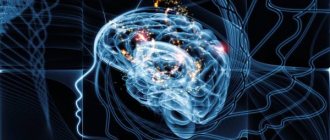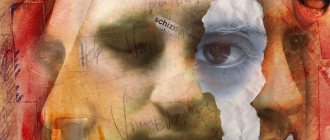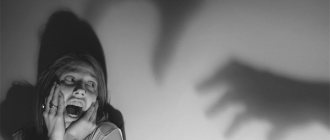general information
Schizophrenia is a multimorphic mental disorder that is caused by the breakdown of emotional reactions and thought processes. It affects both sexes and most often develops between the ages of 20 and 30. The disease affects 0.55-1% of the world population.
Depending on the characteristics of the dominant clinical signs, several types of schizophrenia are distinguished: paranoid, disorganized (hebephrenic), undifferentiated, residual and catatonic.
Catatonia was first described in 1874 by the German psychiatrist K. Kahlbaum as an independent disease. Then E. Kraepelin and E. Bleuler classified it as a symptom complex of schizophrenia. It has now been established that catatonic syndrome can develop against the background of a number of somatic, mental and neurological pathologies.
Causes
The exact causes of schizophrenia, including its catatonic form, have not yet been determined. It is assumed that the following prerequisites play a major role in the pathogenesis of the disease:
- genetic mutations;
- intrauterine infections;
- negative social factors - low income, poor living conditions, and so on;
- unfavorable family atmosphere - parental divorce, quarrels, violence, alcoholism of the mother or father, inadequate parenting methods;
- alcohol abuse, drug addiction;
- character traits - anxiety, excessive scrupulousness, inflated demands on oneself;
- chronic stress, hard mental work, leading to constant overwork.
Symptoms
The catatonic form of schizophrenia is accompanied by all the classic signs of this disorder, namely:
- dementia;
- delusions, fantasies;
- hallucinations;
- decreased emotional reactions;
- speech disorders;
- apathy, lack of will.
The distinctive symptoms of catatonic schizophrenia are psychomotor disorders - stupor and agitation, replacing each other.
Stupor is an immobilized state into which the patient passes spontaneously. It may last for several hours or days. A person, as a rule, is in a sitting or lying position, in many cases unnatural and uncomfortable. He defecates and urinates on himself. Verbal communication with him is almost impossible. With prolonged immobilization, bedsores may form and nerves or blood vessels may be compressed.
Stupor can be oneiric or lucid (rarely observed). In the first case, the patient experiences fantastic visions in which he is the main character. In the second, his consciousness remains clear.
Excitement precedes stupor or occurs immediately after it. A person performs chaotic actions, behaves aggressively, breaks surrounding objects, and is capable of harming himself. This condition can last for several days.
During catatonic stupor or agitation, the following symptoms may appear:
- Rigid tone is extreme tension in all muscles.
- Wax flexibility - the patient fixes the head or limb in the position that a stranger gave it. For example, after the doctor raises his head above the pillow, he freezes in this position for an indefinite period of time (“pillow symptom”).
- Negativism is active or passive resistance to the influences of others. The person either does the opposite or ignores requests.
- Mutism – lack of verbal reactions, silence. Sometimes the patient reacts only to a whisper (Pavlov's symptom).
In addition, a patient with catatonic schizophrenia may:
- act senselessly and stereotypically - shaking something off oneself for several hours in a row, scratching oneself, hitting the table with one's fist;
- automatically obey instructions from the outside against the background of a complete absence of volitional actions;
- copy the movements, facial expressions and words of others, giving them pretentiousness.
Catatonic schizophrenia in children occurs with similar symptoms.
Symptoms of catatonic schizophrenia
A characteristic clinical manifestation of the pathology is motor dysfunction. In this case, the patient either falls into a stupor or into a state of excitement. Stupor can turn into excitement or vice versa at any time.
Symptoms of cattonic schizophrenia are:
- Stupor. During an attack, a person freezes for an indefinite period of time in one, not always comfortable, position. The time spent in stupor lasts from several hours to several days. When a patient does not move for many days, bedsores form on the body. In addition, there is a violation of nerve conduction of tissues and blood circulation. Consciousness was preserved in a state of stupor. Patients see and hear everything, but will not be able to take part in what is happening. In a stupor, the patient may hallucinate and become delusional.
- Excitation. Often characterized by inappropriate, aggressive human behavior. During this state, the patient commits impulsive, destructive actions that do not have specific goals. At the same time, a man or woman can harm not only others, but also himself. Therefore, in a state of agitation and uncontrolled aggression, patients are hospitalized.
Characteristic symptoms of catatonic syndrome:
- Air cushion symptom. A person lying on a flat surface holds his head elevated, as if a pillow was placed under it. It is noteworthy that he remains in this position during sleep.
- Hood sign. The patient wants to hide his head, covering it with a blanket, clothing or other objects.
- Trunk symptom. Basic reflexes appear - grasping, sucking.
- Mutism. During an attack, the patient remains completely silent, but he understands the speech of those around him.
- Negativism. The person categorically refuses to fulfill any requests.
- Echolalia. Characterized by copying the actions, facial expressions, and words of others.
In catatonic schizophrenia, multiple symptoms may occur simultaneously. The patient's condition is depressed; during an attack, aggressiveness is manifested, and there is a lack of perception of others. Patients also suffer from hallucinations and delusions.
Diagnostics
According to the ICD, to make a diagnosis of catatonic schizophrenia, it is necessary that one or more of the following symptoms be confirmed during a psychiatric examination:
- stupor or mutism;
- rigidity;
- waxy flexibility, hardening;
- negativism;
- meaningless activity (excitement);
- stereotypical movements or strange postures;
- automatic compliance.
Clinical signs should be observed for a minimum of 14 days.
During the diagnosis, magnetic resonance imaging of the brain and electroencephalography are performed.
Catatonic schizophrenia is differentiated from:
- encephalitis;
- brain tumors;
- temporal lobe epilepsy;
- affective disorders - mania, depression;
- hysteria;
- metabolic diseases - Tay-Sachs disease, Wilson's syndrome, hyponatremia;
- taking medications and drugs - ciprofloxacin, cocaine, ecstasy.
Causes of the disease
The true causes of the formation of schizophrenia by modern medicine have not been found, but scientists have been able to identify several predisposing factors contributing to the development of catatonic syndrome:
- heredity;
- perinatal factors - infectious pathologies suffered during pregnancy, the season of birth of the child;
- social disadvantage;
- various types of chemical dependency;
- mental trauma;
- psychological and mental tension, emotional stress.
Traditionally, catatonic manifestations are associated with schizophrenia. Experts note the formation of the disease in affective disorders, depression in the elderly, postpartum mental disorders, and temporal lobe epilepsy. People suffering from dementia, thrombotic purpura, addiction to ecstasy and cocaine, and metabolic disorders are prone to developing the disease. Also, one of the causes of catatonia may be hysteria, previous traumatic brain injury, or severe pathologies of an infectious nature.
Treatment
Treatment of the catatonic form of schizophrenia is carried out in a specialized clinic. During attacks of excitement there should be no sharp or breakable objects around the person. During periods of stupor, it is necessary to monitor his vital signs, as well as provide care for him. Prolonged immobilization requires parenteral nutrition and intravenous infusions of rehydration solutions. Drug therapy is selected individually, it depends on the severity of symptoms and the phase of the disease.
In the excitement stage, tranquilizers and neuroleptics (antipsychotics) are used. As a rule, tranquilizers of the benzodiazepine group are used - drugs that have hypnotic, sedative, muscle relaxant and anticonvulsant effects, and also reduce anxiety.
The main antipsychotics are droperidol, sodium hydroxybutyrate, chlorpromazine, haloperidol, levomepromazine. They help suppress the productive symptoms of schizophrenia (delusions, aggression, behavioral disorders). The action of antipsychotics is based on reducing the transmission of nerve impulses in the brain. Many experts believe that the use of antipsychotics in the catatonic form of the disease increases the risk of developing neuroleptic malignant syndrome.
In the phase of catatonic stupor, nootropic drugs are used - drugs that stimulate brain activity and activate cognitive functions. Their effect is based on improving the energy state of brain neurons and activating the transmission of nerve impulses.
In addition, the following are used to treat catatonic schizophrenia:
- mood stabilizers - mood stabilizers;
- Dopamine antagonists – drugs that block dopamine receptors;
- muscle relaxants - medications that reduce the tone of skeletal muscles.
If other methods are ineffective, electroconvulsive therapy is used, the essence of which is to pass an electric current through the patient’s brain. It has a number of side effects.
Catatonic agitation
Catatonic arousal differs from arousal in the structure of hallucinatory-paranoid symptoms or manic in that it has no motivation and is completely meaningless. Actions are performed chaotically, they have no logical connection and are directed both at external objects and at themselves. It is difficult to say whether the patient is aware of his “I” during this state.
- Confused and pathetic. Thinking during actions is disconnected and not connected with actions. Confusion and lack of adequate motivation come to the fore. The patient may march, recite poetry, sing, play imaginary musical instruments, argue, etc.
- Hebephrenic agitation. Active facial expressions, gaiety for no reason, and foolishness are observed.
- Impulsive excitement. The behavior is destructive, aggressive, in this state any destructive actions are possible, directed at oneself or others.
Forecast
To date, no means have been developed to completely cure catatonic schizophrenia. This form of the disease is considered prognostically unfavorable. As a rule, it is chronic and is accompanied by a gradual worsening of disorders and loss of ability to work.
Thanks to medication, it is possible to smooth out the pathological manifestations of the disorder, prevent relapses of attacks and improve the patient’s quality of life. He needs constant care and condition monitoring.
Prevention
Basic measures for primary prevention of catatonic form of schizophrenia:
- medical and genetic counseling at the stage of family planning;
- prevention of toxic and infectious effects on the fetus during pregnancy;
- raising a child in a friendly atmosphere;
- moderate alcohol consumption, drug abstinence;
- proper rest, avoidance of stressful situations.
The goal of secondary prevention of schizophrenia is to prevent worsening symptoms and exacerbations of the disease. It includes:
- early diagnosis of pathology;
- taking maintenance doses of medications prescribed by a doctor;
- psychotherapy;
- social rehabilitation.
Story
As an independent mental disorder, the catatonic form of schizophrenia was first described by the German psychologist Karl Ludwig Kahlbaum in the sixties of the 19th century. He announced this syndrome at a congress of psychiatrists in Innsbruck, noting that he has special symptoms that, in addition to the emotional sphere, also affect the motor sphere.
Kahlbaum's disease, as it is often called in memory of its discoverer, can appear in people under 50 years of age at any period of life, even in the youngest. In children it can be determined by monotonous movements of the body, in children 5–6 years old - by sniffing and licking surrounding objects. But usually catatonia strikes people aged 16–30 years. The first signs appear earlier in males.
It should be noted that earlier, until the fifties of the twentieth century, such a serious disease occurred quite often, especially among young people, but since then this trend has declined. Currently, only 1–3 patients with schizophrenia are diagnosed with it.











